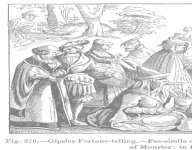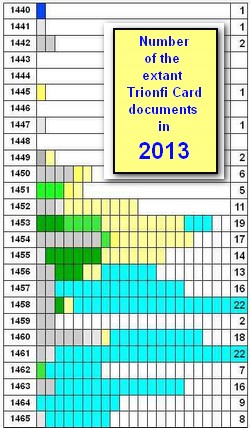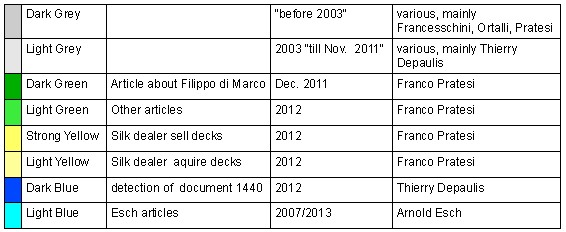Rosanne
History of Tarot cards and the History of their Use is really not so far apart.
Here is a compiled list 'Fortune telling devices' - alphabetical of course :}
Alectromancy: by observation of a rooster pecking at grain
Astrology: by the movements of celestial bodies.
Astromancy: by the stars.
Augury: by the flight of birds.
Bazi or four pillars: by hour, day, month, and year of birth.
Bibliomancy: by books; frequently, but not always, religious texts.
Cartomancy: by playing cards, tarot cards, or oracle cards.
Ceromancy: by patterns in melting or dripping wax.
Cheiromancy: by the shape of the hands and lines in the palms.
Chronomancy: by determination of lucky and unlucky days.
Clairvoyance: by spiritual vision or inner sight.
Cleromancy: by casting of lots, or casting bones or stones.
Cold reading: by using visual and aural clues.
Crystallomancy: by crystal ball also called scrying.
Extispicy: by the entrails of animals.
Face Reading: by means of variations in face and head shape.
Feng shui: by earthen harmony.
Gastromancy: by stomach-based ventriloquism (historically).
Geomancy: by markings in the ground, sand, earth, or soil.
Haruspicy: by the livers of sacrificed animals.
Horary astrology: the astrology of the time the question was asked.
Hydromancy: by water.
I Ching divination: by yarrow stalks or coins and the I Ching.
Kau cim by means of numbered bamboo sticks shaken from a tube.
Lithomancy: by stones or gems.
Necromancy: by the dead, or by spirits or souls of the dead.
Numerology: by numbers.
Oneiromancy: by dreams.
Onomancy: by names.
Palmistry: by lines and mounds on the hand.
Parrot astrology: by parakeets picking up fortune cards
Paper fortune teller: origami used in fortune-telling games
Pendulum reading: by the movements of a suspended object.
Pyromancy: by gazing into fire.
Rhabdomancy: divination by rods.
Runecasting or Runic divination: by runes.
Scrying: by looking at or into reflective objects.
Spirit board: by planchette or talking board.
Taromancy: by a form of cartomancy using tarot cards.
Tasseography or tasseomancy: by tea leaves or coffee grounds.
Lets take one, that is not Tarot and see if we can find when it started with PROOF.
Ceromancy!
First of all you need wax made into candles.......... maybe the History of Bees.... Lets go to Egypt! Maybe Mesopotamia!
~Rosanne
Here is a compiled list 'Fortune telling devices' - alphabetical of course :}
Alectromancy: by observation of a rooster pecking at grain
Astrology: by the movements of celestial bodies.
Astromancy: by the stars.
Augury: by the flight of birds.
Bazi or four pillars: by hour, day, month, and year of birth.
Bibliomancy: by books; frequently, but not always, religious texts.
Cartomancy: by playing cards, tarot cards, or oracle cards.
Ceromancy: by patterns in melting or dripping wax.
Cheiromancy: by the shape of the hands and lines in the palms.
Chronomancy: by determination of lucky and unlucky days.
Clairvoyance: by spiritual vision or inner sight.
Cleromancy: by casting of lots, or casting bones or stones.
Cold reading: by using visual and aural clues.
Crystallomancy: by crystal ball also called scrying.
Extispicy: by the entrails of animals.
Face Reading: by means of variations in face and head shape.
Feng shui: by earthen harmony.
Gastromancy: by stomach-based ventriloquism (historically).
Geomancy: by markings in the ground, sand, earth, or soil.
Haruspicy: by the livers of sacrificed animals.
Horary astrology: the astrology of the time the question was asked.
Hydromancy: by water.
I Ching divination: by yarrow stalks or coins and the I Ching.
Kau cim by means of numbered bamboo sticks shaken from a tube.
Lithomancy: by stones or gems.
Necromancy: by the dead, or by spirits or souls of the dead.
Numerology: by numbers.
Oneiromancy: by dreams.
Onomancy: by names.
Palmistry: by lines and mounds on the hand.
Parrot astrology: by parakeets picking up fortune cards
Paper fortune teller: origami used in fortune-telling games
Pendulum reading: by the movements of a suspended object.
Pyromancy: by gazing into fire.
Rhabdomancy: divination by rods.
Runecasting or Runic divination: by runes.
Scrying: by looking at or into reflective objects.
Spirit board: by planchette or talking board.
Taromancy: by a form of cartomancy using tarot cards.
Tasseography or tasseomancy: by tea leaves or coffee grounds.
Lets take one, that is not Tarot and see if we can find when it started with PROOF.
Ceromancy!
First of all you need wax made into candles.......... maybe the History of Bees.... Lets go to Egypt! Maybe Mesopotamia!
~Rosanne




